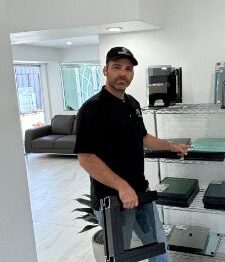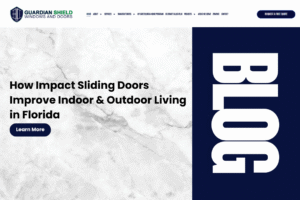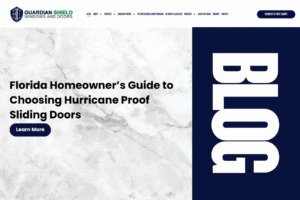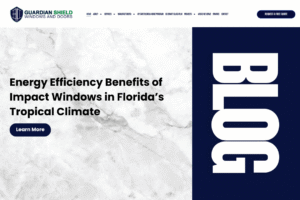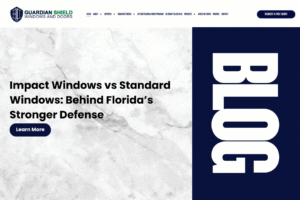Hurricane Irma’s devastation, which left 90% of Barbuda’s buildings damaged and 60% of its population homeless, highlights the urgent need for robust hurricane protection. For residents of the Caribbean and southern U.S., selecting the right hurricane impact windows is critical. This guide will walk you through the top six factors to consider to ensure your property is well-protected against the increasing threat of hurricanes.
The Importance of Impact Windows
Impact windows are crucial for providing comprehensive protection against hurricanes and other severe weather events. These windows are designed to resist shattering upon impact, which helps maintain the structural integrity of your home. This resistance to breakage prevents debris from entering your home, protecting both the interior and the occupants.
Moreover, impact windows offer additional benefits such as improved energy efficiency and noise reduction. They are built with multiple layers of glass and a special interlayer that provides insulation, keeping your home cooler in the summer and warmer in the winter. This energy efficiency can lead to lower utility bills, making impact windows a smart long-term investment.
Photo by Jose Francisco Fernandez Saura: https://www.pexels.com/photo/interior-design-of-room-at-hotel-20559717/
1. Corrosion Resistance
Hurricane-prone coastal regions require windows that can resist corrosion caused by salty sea air. Corrosion-resistant windows are designed with advanced materials and coatings to withstand harsh coastal environments. Investing in these windows not only extends their lifespan but also enhances the overall resilience of your property during severe weather conditions.
Recent hurricanes like category-3 Hurricane Idalia underscore the importance of durable building materials in coastal areas. Corrosion-resistant windows are essential, providing long-term protection and contributing to the structural integrity of your home.
2. Ensuring Long-Term Protection
Durability is a key factor in selecting hurricane impact windows. In regions like Florida, buildings undergo inspections every 40 years to ensure compliance with safety standards. High-impact windows must meet these standards to avoid costly replacements.
Durable windows withstand strong winds, heavy rain, and airborne debris. They maintain the structural integrity of your home, preventing shattering and reducing the risk of injury. Additionally, durable windows have effective sealing mechanisms to prevent water infiltration, protecting your property from water damage during storms.
Photo by miyu: https://www.pexels.com/photo/silhouette-of-people-in-front-of-a-window-20805570/
3. Hurricane Resistance Levels
Understanding hurricane resistance levels is crucial when selecting impact windows. Hurricanes vary in intensity, and your windows should be able to withstand the most severe conditions in your area. Category five hurricanes, the strongest, require the highest level of impact resistance.
By choosing windows with appropriate resistance levels, you ensure that your home is protected during even the most intense storms. This proactive approach fortifies your property against the unique challenges posed by hurricanes.
4. Adherence to Building Codes
To stay compliant with the law, it’s essential to choose windows that meet local building codes. Both federal and state regulations, particularly in hurricane-prone areas like Florida, have stringent requirements for glass windows.
Florida’s building codes include specific provisions for wind load requirements, roofing materials, and elevation to mitigate flood risks. Buying windows from manufacturers who understand and adhere to these codes ensures compliance and enhances the resilience of your property against hurricanes.
Photo by Meruyert Gonullu: https://www.pexels.com/photo/modern-building-of-shopping-mall-with-glass-wall-6161510/
5. Local Manufacturing
Locally manufactured hurricane impact windows are designed to meet the specific environmental and climatic conditions of regions like Florida and the Caribbean. These windows adhere to stringent building codes and are crafted to withstand local temperatures and wind conditions.
Choosing local windows not only ensures compliance with regional codes but also supports local businesses. Locally produced windows are tailored for optimal performance in your area, providing reliable protection and uninterrupted views of your surroundings.
6. Balancing Quality and Price
While hurricane impact windows are a premium investment, understanding the cost factors can help you make an informed decision. Locally manufactured windows can reduce costs associated with taxes, stamp duty, and transportation.
According to Architectural Digest, the average cost of hurricane-impact windows ranges from $1,900 to $10,000, with a national average of $5,332. Prices vary based on window type, size, materials, installation complexity, and additional features. Investing in high-quality windows ensures long-term durability and protection, making it a worthwhile expenditure for safeguarding your property.
Conclusion
Selecting the right hurricane impact windows is vital for protecting your home from the devastating effects of hurricanes. By considering factors such as corrosion resistance, durability, hurricane resistance levels, adherence to building codes, local manufacturing, and cost, you can make an informed decision that ensures the safety and resilience of your property.
FAQs
1. What are hurricane impact windows?
Hurricane impact windows are specially engineered to withstand the extreme forces generated by hurricanes and other severe weather events. These windows are constructed with multiple layers of glass and interlayers, typically using laminated glass, which prevents shattering upon impact. The design helps protect buildings from strong winds, flying debris, and pressure changes, thereby reducing the risk of damage and enhancing the safety of occupants.
2. How do I know if a window is hurricane resistant?
To determine if a window is hurricane-resistant, look for specific certifications and compliance marks. Windows should meet the standards set by organizations such as the American Society for Testing and Materials (ASTM) and the Miami-Dade County for hurricane-prone areas like Florida. These certifications indicate that the windows have passed rigorous testing for impact resistance and wind pressure. Additionally, you can check the window’s DP (Design Pressure) rating, which measures its ability to withstand wind pressure and water infiltration. Ensure the windows are rated for the specific wind speeds and impact levels typical in your region.
3. Why is corrosion resistance important for hurricane windows?
Corrosion resistance is vital for hurricane impact windows, especially in coastal areas where the air is salty and humid. These conditions can accelerate the corrosion of metal components in windows, such as frames, hardware, and fasteners. Corrosion can weaken the structural integrity of the windows, making them less effective in providing protection during a hurricane. Therefore, windows designed with corrosion-resistant materials, like stainless steel or treated aluminum, are essential to ensure durability, longevity, and continued performance against severe weather conditions.
4. Are locally manufactured windows better for hurricane protection?
Locally manufactured windows can be advantageous for hurricane protection as they are designed with the specific environmental and climatic conditions of the region in mind. Local manufacturers are more likely to be familiar with regional building codes and standards, ensuring that their products meet or exceed these requirements. Additionally, using locally sourced materials and labor can support the local economy and reduce shipping costs and times. Locally manufactured windows may also provide better customer service and quicker response times for repairs or replacements.
5. What factors influence the cost of hurricane impact windows?
Several factors can influence the cost of hurricane impact windows:
- Type and Size: Larger windows and more complex window types (such as sliding doors or custom shapes) generally cost more.
- Materials Used: The choice of frame material (e.g., vinyl, aluminum, wood-clad) and the type of glass (e.g., laminated, insulated) affect the price.
- Installation Complexity: Difficult or labor-intensive installations, such as those requiring structural modifications or working in hard-to-reach areas, can increase costs.
- Property Requirements: Specific building requirements or aesthetic considerations, such as historical preservation or matching existing designs, may add to the cost.
- Additional Features: Optional features like tints, coatings for energy efficiency, noise reduction, or enhanced security can also raise the price.
- Customization: Customized designs or special orders tailored to unique specifications tend to be more expensive than standard, off-the-shelf options.

